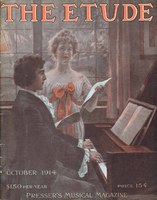S. C. S.—Beginners on string instruments are often subject to cramps and pains in the muscles in either right or left hand or arm. The motions involved in violin playing bring into play muscles which would not otherwise be used in the same way, and they are subject to cramps until they get accustomed to their work. Possibly your pupil grips the neck of the violin too tightly with the left hand. This is a very great fault, as the hand should grasp the neck lightly, and have free play up and down the neck in shifting. If the position of the hand is correct, your idea of discontinuing the practice when the cramp appears and then resuming in a few minutes is a good one. Massage of the hand would no doubt assist, or an osteopath might help your pupil. If after following the above course the cramp persists, it would be best to consult a good physician or surgeon.
Mrs. J. L. McF.—I could not give even a guess at the value of your violin without seeing it. According to the data you sent, your violin was not made by a famous violin maker, and consequently it would have no historical value apart from its value for its tone qualities. There are hundreds of thousands of violins in the world made by more or less obscure violin makers of the past and present. Some of these violins have admirable tone qualities and possess considerable value as musical instruments. If you have a violin expert or reliable violin dealer near your home, he could no doubt give you an idea of the value of your violin.
S. U.—If at the age of sixteen, and having played the violin for four years, you are able to play Kreutzer, Fiorillo and Rode even passably well, you have made remarkable progress. If you have really good talent you are not at all too old to continue, with the idea of making violin playing your profession. It all depends on your talent. However, it is a great misfortune to choose a profession for which one has not the requisite talent. You had best go to a really first rate violinist, one with a reputation in the musical world, and pay him a fee to examine you as to talent, and to advise you. Such an examination might save you years of misapplied labor in a profession for which you are not fitted.
O. S. G.—The chromatic scale (glissando), from the cadenza in the arrangement of Drdla’s Serenade which you send, commencing on E, two octaves above the open E string, should be executed with a single finger, in this case preferably the third. The finger proceeds down the string with a series of quick, even little jerks, until the first position is reached, when the ordinary chromatic scale fingering is resumed.
It is very difficult indeed to play the chromatic scale in this manner, in perfect tune, since as the finger proceeds down the string the distance traversed by the finger between the half tones, becomes slightly greater in progressive ratio, owing to the lengthening of the vibrating portion of the string. Such passages are often attempted by violinists without sufficient practice, and are simply “faked,” the true intervals of the chromatic scale not being produced at all.
S. N. R.—If you have only been studying the violin for three years, and play third or fourth grade music, you are wasting your time in trying to play double harmonics. Double stops in artificial harmonics are extremely difficult, and are only successfully played by great virtuoso violinists. They involve extraordinary accuracy in placing the fingers, and some of them involve great powers of stretching. Such difficult feats come at the very end of the education of a violinist, after he has thoroughly mastered ordinary violin technic in all its forms. Double harmonics are only effective when the tones are brought out with great clearness and penetration. When played with a sickly, feeble tone, and with many of them “missing fire” altogether, they are of no effect, and had best not be attempted.
C. R.—You can buy a quilted blanket to cover your violin in the case from any large music house, or you can make one yourself. Cut two pieces of silk into a long tapering oval shape of the proper size to fit over the top of your violin, put cotton between them, and run lines of stitching at regular intervals as you would in making a quilt. Such a covering forms an excellent preventive against dampness, violent atmospheric changes, and also protects the violin from injury while in the case, from the bow striking it, or other cause.
J. A. G.—As far as I can judge from the description you send of the position of your arm in playing the staccato bowing I am inclined to think that the advice given you by the pupil of Sevcik was correct, but in matters of this kind it is simply impossible to judge from a written description, since the position of the arm and hand is constantly changing as the bow advances and recedes in bowing, and the elbow rises and falls conforming to which string is being played, or when two strings are played at once. I would have to see you play to judge whether you are doing this bowing correctly or not. If you could go to a first class teacher for even a single lesson he could no doubt straighten out the matter for you.



